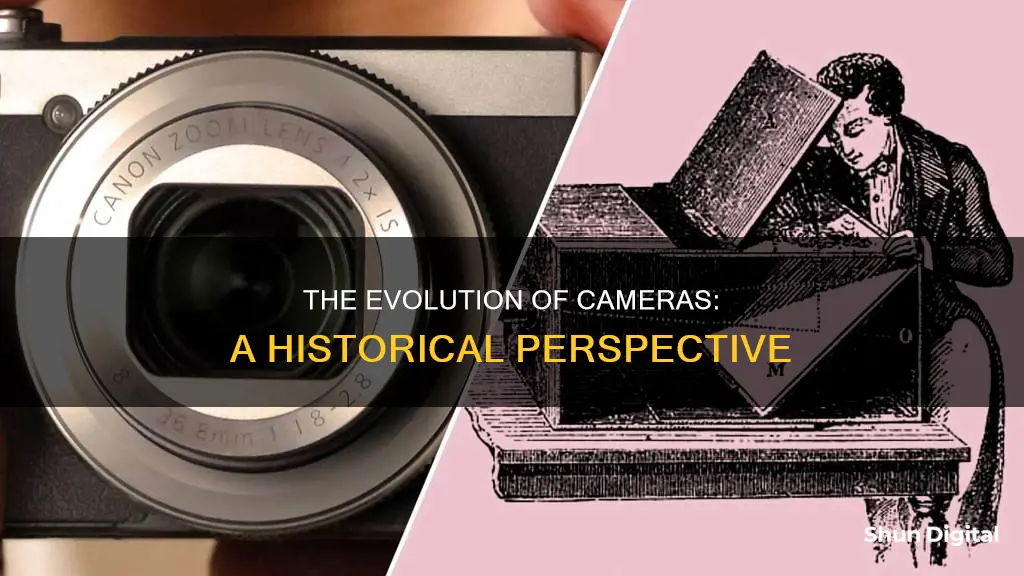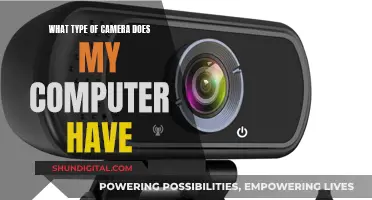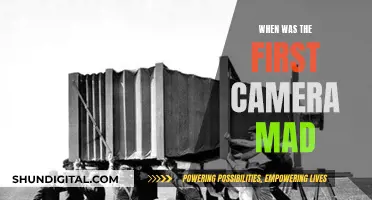
The history of the camera is a long and fascinating one, dating back centuries before the first photograph was ever taken. The concept of a camera began with the camera obscura, a dark room or box with a small hole that projected an inverted image of the outside world onto the opposite wall. This idea was first described by Han Chinese scholar Mozi around 400 BC and later observed by Aristotle in relation to sunlight travelling through the spaces between leaves.
Over time, the camera obscura evolved and, in 1816, French inventor Joseph Nicéphore Niépce created the first camera capable of capturing permanent photographic images. He achieved this by using a camera obscura and a pewter plate coated with Bitumen of Judea, a light-sensitive material that hardened in proportion to the amount of light it received. This process, which Niépce called heliography, produced the world's first photograph in 1826, depicting the view from his home in Le Gras, France.
In the following years, several pioneers made significant breakthroughs in camera technology. In 1839, Niépce's partner, Louis Daguerre, invented the daguerreotype, a portable box camera that used a plate coated with silver iodide. This camera produced positive images, or mirror images, and required exposure times of several minutes or hours. Daguerreotypes became extremely popular, and the French government presented the technology as a gift to the world.
Around the same time, in 1839, Englishman William Henry Fox Talbot unveiled his camera, the calotype, which used a different series of chemical processes to create negative images. While the calotype had slower exposure times than the daguerreotype, it was the first step towards using paper instead of plates for photographs.
The first mass-marketed camera was a daguerreotype camera produced by Alphonse Giroux in 1839, costing 400 francs (approximately $7,000 today). This was followed by George Eastman's invention of the first roll film camera, the Kodak, in 1888. The Kodak camera cost only $25 and came with the catchy slogan, You press the button... we do the rest.
Today, cameras are an integral part of our daily lives, with digital cameras and camera phones offering high-quality images and videos at our fingertips.
| Characteristics | Values |
|---|---|
| First camera ever made | Camera obscura |
| First camera invented | 1816 |
| Inventor of the first camera | Frenchman Joseph Nicéphore Niépce |
| First photograph | Taken in 1826 by Joseph Nicéphore Niépce |
| First photographic camera | Developed in 1816 by Joseph Nicéphore Niépce |
| First mass-marketed camera | Daguerreotype camera produced by Alphonse Giroux in 1839 |
| First roll film camera | The Kodak camera created by American entrepreneur George Eastman in 1888 |
| First movie camera | Chronophotographic gun invented by Étienne-Jules Marey in 1882 |
| First single-lens reflex camera | Developed by Thomas Sutton in 1861 |
| First mass-marketed single-lens reflex camera | Italian Rectaflex |
| First digital camera | Created by Steven Sasson in 1975 |
| First commercially available handheld digital camera | Dycam Model 1 created by Logitech in 1990 |
| First camera phone | Kyocera VP-210 developed in 1999 |
What You'll Learn

Camera obscura
The camera obscura, which translates to "dark room" in Latin, is a natural optical phenomenon where light rays passing through a small hole into a darkened space create an inverted and reversed projection of the outside view. This phenomenon has been known since ancient times, with the earliest documented explanation coming from Han Chinese philosopher Mozi around 470 to 391 BC. The camera obscura was used for various purposes, including studying eclipses without damaging one's eyes, drawing and painting aids, entertainment, and understanding light properties.
The device typically consists of a box, tent, or room with a small aperture on one side, allowing external light to pass through and strike a surface inside, creating an inverted and reversed image. The image can be viewed from the back, appearing upright but still reversed. This technology was further developed into the photographic camera in the first half of the 19th century, when camera obscura boxes were used to expose light-sensitive materials to the projected image.
The camera obscura played a significant role in the history of art, with draughtsmen and painters using it to create accurate and detailed sketches of landscapes and architecture. It was particularly useful for capturing perspective and representing three-dimensional scenes on a two-dimensional surface. There is evidence that artists such as Canaletto and Rembrandt used the camera obscura, and it is widely speculated that Dutch Masters like Johannes Vermeer may have employed this technique to achieve their remarkable attention to detail.
The camera obscura was also a valuable tool for wealthy individuals taking the "Grand Tour" in the 1700s and 1800s, allowing them to create drawings of Italian landscapes and classical ruins. However, the camera obscura only focused and reflected light; it did not capture it. The next significant advancement came in the 1800s when a device like the camera obscura was combined with light-sensitive materials, leading to the birth of photography.
Best Buy's Camera Battery Charger Options Explored
You may want to see also

The first photograph
The world's first photograph was taken in 1826 or 1827 by Joseph Nicéphore Niépce, a French inventor and photographer. The photograph, known as "View from the Window at Le Gras", was captured using a camera obscura and a bitumen-coated pewter plate. The image depicts a simple scene of the rooftops, a tree, and the surrounding landscape of Niépce's estate in Saint-Lop-de-Varenees, Burgundy, France.
The process, known as heliography, involved exposing a polished pewter plate coated with bitumen to light, which hardened the bitumen in proportion to the amount of light that hit it. After exposure, Niépce used a solvent to wash away the soluble parts of the photosensitive material, revealing a latent image on the plate. While this was a groundbreaking process, it had its limitations, including very long exposure times, often requiring several hours or even days.
Charging Lorex Cameras: Quick and Easy Guide
You may want to see also

The daguerreotype
The process involved polishing a sheet of silver-plated copper to a mirror finish, treating it with fumes to make its surface light-sensitive, and then exposing it in a camera for as little as a few seconds or much longer, depending on the intensity of the light. The resulting latent image was made visible by fuming it with mercury vapour, and then removing its sensitivity to light with a liquid chemical treatment. The image was then rinsed, dried, and sealed behind glass in a protective enclosure.
Understanding Camera Raw: A Powerful Plugin for Photographers
You may want to see also

The first photographic camera
Niépce created photographic images on silver chloride-lined paper, and the oldest extant photograph is one he made around 1826. The original shot is still on exhibit at the University of Texas at Austin. This photograph is considered the first permanent photograph of a camera image. It was made using an 8-hour exposure on pewter coated with bitumen. Niépce called his process "heliography".
Niépce corresponded with the inventor Louis-Jacques-Mandé Daguerre, and the pair entered into a partnership to improve the heliographic process. Niépce had experimented with other chemicals to improve contrast in his heliographs. Daguerre contributed an improved camera obscura design, but the partnership ended when Niépce died in 1833.
Daguerre succeeded in developing a high-contrast and extremely sharp image by exposing a plate coated with silver iodide to mercury vapour. By 1837, he was able to fix the images with a common salt solution. He called this process Daguerreotype, and tried unsuccessfully for a couple of years to commercialize it. Eventually, with the help of the scientist and politician François Arago, the French government acquired Daguerre's process for public release.
In the 1830s, the English scientist William Henry Fox Talbot independently invented a process to capture camera images using silver salts. Although dismayed that Daguerre had beaten him to the announcement of photography, he submitted a pamphlet to the Royal Institution entitled "Some Account of the Art of Photogenic Drawing" on 31 January 1839, which was the first published description of photography.
The journey from the first cameras to modern global DSLR cameras has spanned centuries.
Battery Life of 220 Camera: How Long Does It Last?
You may want to see also

The gelatin dry plate
Moreover, the gelatin dry plate contributed to the development of commercial photography. George Eastman, a clever inventor, and businessman founded the Eastman Film and Dry Plate Company in 1881, capitalizing on the growing demand for dry plates. He understood the potential of photography as a convenient and accessible medium and set out to make it available to everyone. Eastman's company later introduced the first roll film camera, the Kodak, in 1888, which used celluloid film and offered 100 exposures per roll.
In conclusion, the gelatin dry plate was a pivotal innovation that transformed photography. It simplified the process, improved sensitivity, and made photography more accessible to amateurs and professionals alike. The dry plate's convenience and versatility laid the foundation for the modern photography industry, paving the way for further advancements in photographic technology and changing the way we capture and preserve our world.
AGS Mode Camera Stopped: What's the Fix?
You may want to see also







